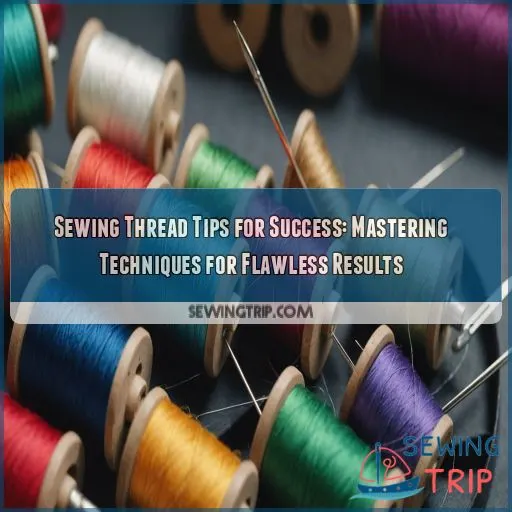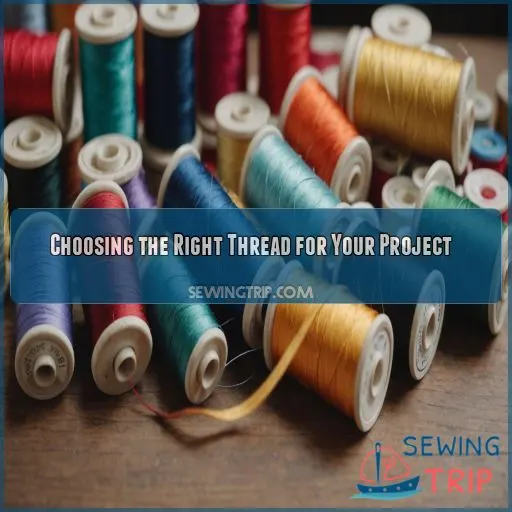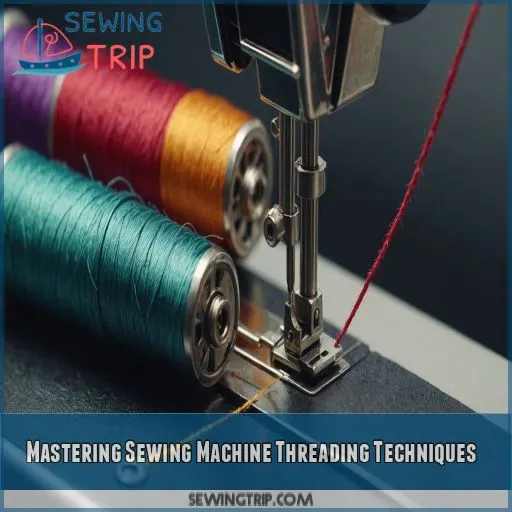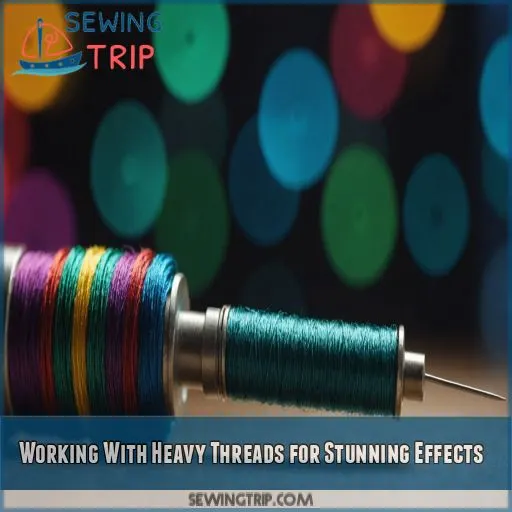This site is supported by our readers. We may earn a commission, at no cost to you, if you purchase through links.
 First, think about the match between your thread and fabric – lightweight fabrics need delicate threads, while heavy-duty materials crave beefier options. Don’t forget to think about stretch; nobody wants a wardrobe malfunction!
First, think about the match between your thread and fabric – lightweight fabrics need delicate threads, while heavy-duty materials crave beefier options. Don’t forget to think about stretch; nobody wants a wardrobe malfunction!
Threading your machine might feel like solving a puzzle, but practice makes perfect. Tension is key, so adjust until you find that Goldilocks sweet spot.
And hey, don’t be afraid to experiment with fancy threads – metallic, variegated, or invisible – to add some pizzazz to your projects.
Ready to thread your way to sewing stardom? Let’s get started!
Table Of Contents
Key Takeaways
- Don’t let thread troubles get you down! Choosing the right thread for your fabric is like finding the perfect dance partner – it’s all about matching weight, fiber, color, and strength to create a beautiful, long-lasting bond.
- Mastering your sewing machine’s threading technique is key to avoiding those pesky tangles and tension troubles – think of it like guiding a thread through a maze, where one wrong turn can lead to a big mess!
- Experimenting with specialty threads is like adding a secret ingredient to your favorite recipe – it can take your sewing projects from ordinary to extraordinary, adding unique textures, colors, and effects that make your creations truly pop!
- Remember, thread is the unsung hero of your sewing projects, working behind the scenes to create those perfect stitches – so take the time to choose the right one, and don’t be afraid to get creative and try new things – your fabric (and your sewing machine) will thank you!
Choosing the Right Thread for Your Project

Choosing the right thread for your sewing project can make or break your final result. Whether you’re a beginner or a seasoned pro, understanding how to match thread weight, fiber, color, and strength to your fabric will make sure your stitches are strong, durable, and look fantastic.
Matching Thread Weight to Fabric Type
You’re the thread matchmaker! Pair light threads with delicate fabrics to avoid puckering. For heavy-duty materials, go bold with thicker threads. It’s like finding the perfect dance partner for your fabric!
Considering Thread Fiber Composition
When choosing thread, think fiber composition. Natural threads like cotton breathe with fabrics, while synthetic polyester offers strength. Blends give you the best of both worlds. Match thread properties to your fabric’s needs for amazing results.
Selecting Appropriate Thread Color and Sheen
Now, let’s talk color! Your thread’s shade and shine can make or break your project. It’s like choosing the perfect accessory – you want it to complement, not clash. Here’s how:
Understanding Thread Strength and Durability
- Thread testing: Give it a good tug
- Thread lifespan: Will it stand the test of time?
- Thread wear: How well does it handle friction?
- Thread knotting: Does it stay put?
Evaluating Specialty Threads for Specific Applications
Beyond standard options, specialty threads open up a world of creative possibilities. From shimmering metallic to textured novelty threads, you’ll find the perfect match for embroidery, quilting, or that eye-catching topstitching project.
Mastering Sewing Machine Threading Techniques
You’re about to become a threading pro, and your sewing machine will thank you for it. With these essential techniques, you’ll banish bunched threads and tension troubles, ensuring your projects come out picture-perfect every time.
Proper Upper Thread Path and Tension
Now that you’ve chosen the perfect thread, let’s tackle the upper thread path. It’s like guiding your thread through a maze – one wrong turn and you’re in a tangle!
Correct Bobbin Winding and Insertion
Now that you’ve got your upper thread sorted, let’s tackle the bobbin. It’s the unsung hero of your sewing machine, working behind the scenes to create those perfect stitches.
Adjusting Thread Tension for Optimal Results
Now that you’ve mastered bobbin winding, let’s tackle thread tension. It’s the secret sauce for perfect stitches! Too tight? Your fabric puckers. Too loose? You’ll see loops. Let’s find that sweet spot.
Using the Right Needle Size and Type
Don’t let needle confusion needle you! Picking the right size and type is key to smooth sailing. Let’s unravel the mystery and get you stitching like a pro in no time.
Troubleshooting Common Threading Issues
Now that you’ve got the right needle, let’s tackle those pesky threading issues. Ever feel like your machine’s playing tricks on you? Don’t worry, we’ll unravel these common problems together.
Working With Heavy Threads for Stunning Effects
Heavy threads can take your sewing projects to the next level, adding bold textures and eye-catching details. Whether you’re quilting, thread painting, or creating decorative stitches, mastering the art of working with heavy threads will open up a world of creative possibilities.
Selecting Appropriate Needle Sizes for Heavy Threads
Now that you’ve mastered threading, let’s tackle needle sizes for heavy threads. It’s like finding the perfect dance partner – too small, and you’ll step on toes. Let’s get it right!
Adjusting Stitch Length and Tension
Now that you’ve got the right needle, let’s fine-tune your stitch. Adjusting stitch length and tension can make or break your heavy thread project. It’s like finding the perfect dance partner!
Techniques for Quilting With Heavy Threads
Ready to jazz up your quilting? Heavy threads can add serious wow-factor to your projects. Here are some techniques to help you master this bold approach:
- Use a walking foot for even feed
- Experiment with decorative stitches
- Try free-motion quilting for texture
- Combine heavy top thread with fine bobbin thread
Thread Painting and Decorative Stitching Tips
Ready to take your quilting to the next level? Thread painting and decorative stitching with heavy threads can add wow-factor to your projects. Let’s explore some tips to make your designs pop!
Combining Heavy Top Threads With Finer Bobbin Threads
Want to create stunning effects with heavy threads? Try pairing them with finer bobbin threads. This combo offers:
- Reduced bulk
- Improved tension
- Enhanced stitch quality
You’ll be sewing like a pro in no time!
Enhancing Your Sewing With Specialty Threads
Specialty threads can take your sewing projects from ordinary to extraordinary, adding unique textures, colors, and effects. Whether you’re looking to add sparkle with metallic threads or create eye-catching patterns with variegated options, mastering these specialty threads will open up a world of creative possibilities for your sewing endeavors.
Exploring Metallic and Glitter Thread Options
Ready to add some sparkle to your sewing? Let’s explore metallic and glitter threads! These eye-catching options can transform your projects from ordinary to extraordinary. But they can be tricky – here’s what you need to know.
Using Variegated Threads for Visual Interest
Now, let’s spice things up! Variegated threads are like a party on your fabric. These color-changing wonders can turn simple stitches into eye-catching designs. Ready to play with rainbows?
Incorporating Invisible Thread in Your Projects
While variegated threads add flair, invisible thread‘s your secret weapon for stealth stitching. It’s perfect for quilting, appliqué, and hems where you want the focus on your fabric, not your thread.
Working With Elastic and Stretch Threads
Ready to tackle stretchy fabrics? Elastic and stretch threads are your secret weapons. They’ll give your garments the flexibility they need, whether you’re sewing yoga pants or comfy underwear. Let’s get started!
Experimenting With Textured and Novelty Threads
Ready to jazz up your sewing? Textured and novelty threads are your ticket to eye-catching projects. From fuzzy to shimmery, these threads add pizzazz. Let’s explore how to use them like a pro!
Frequently Asked Questions (FAQs)
What are the three qualities of a good sewing thread?
Did you know 90% of sewing issues stem from poor thread choice? You’ll want a thread that’s strong, smooth, and color-fast. These qualities mean your stitches will hold up, glide effortlessly, and maintain their hue wash after wash.
What is the most common mistake when threading a sewing machine?
You’re not alone if you’ve skipped a thread guide! This sneaky mistake can cause major headaches. Double-check that your thread’s hitting every guide on its journey. It’s like following a roadmap – miss a turn, and you’ll end up lost!
Why does my thread bunch when I sew?
A stitch in time saves nine, but thread bunching can unravel your patience! You’re likely facing incorrect tension, improper threading, or a raised presser foot. Double-check these culprits, and you’ll be sewing smoothly in no time.
How do you strengthen sewing thread?
Want stronger thread? Double it up! Run two strands through your needle or use a thicker weight. You can also apply beeswax for added durability. Just remember, beefier thread needs a bigger needle to match!
How do I prevent thread from tangling while hand-sewing?
Don’t let tangled thread tie you in knots! Keep your thread short, about 18 inches. Condition it with beeswax or thread conditioner. Untwist your needle regularly and avoid yanking. You’ll be stitching smoothly in no time!
Can I use regular thread for machine embroidery?
While you can use regular thread, it’s not ideal for machine embroidery. You’ll get better results with specialized embroidery thread. It’s smoother, stronger, and comes in a dazzling array of colors. Your designs will thank you!
What causes thread to break during sewing?
You’re not alone if your thread’s breaking like crazy! It’s often due to tension troubles, dull needles, or using the wrong thread for your fabric. Check these culprits, and you’ll be stitching smoothly in no time!
How often should I replace my sewing machine needle?
You’ll want to swap out your sewing machine needle after every 8-10 hours of stitching or when you switch fabric types. If you’re hearing a "pop" with each stitch, it’s definitely time for a fresh needle!
Is it necessary to match bobbin thread color?
Think of your bobbin thread as the behind-the-scenes partner – it doesn’t need to match the star of the show (your top thread) exactly, but choose a color that blends in to avoid distracting from your design.
Conclusion
You’re on the cusp of sewing stardom! Mastering sewing thread tips for success takes time and practice, but the payoff is worth it.
By choosing the right thread, mastering machine threading techniques, and experimenting with specialty threads, you’ll be well on your way to flawless results.
Happy sewing – and don’t forget to show off your creations!









